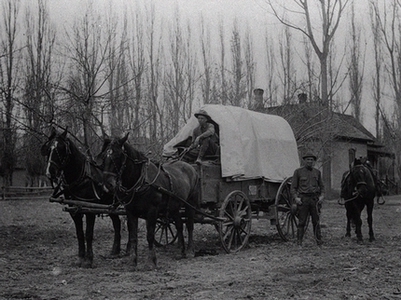THE FOREST SERVICE IN UTAH

Forest Service crew in Salina, 1917
Shortly after arriving in the Salt Lake Valley, the pioneers constructed sawmills in the nearby canyons. Several Utah businessmen prospered from these and other types of lumber operations up to and until Utah logging reached its peak in 1880. Unfortunately, this unregulated logging together with overgrazing by livestock left many of Utah's mountain slopes denuded. Consequently, between 1880 and 1884, Utah became a net importer of lumber. By 1890, range and forest deterioration had become critical.
In the long run, grazing on Utah's forests proved even more damaging than did logging. The federal government initially did little to effectively regulate the use of grazing on forest land in the West until influential private organizations and citizens provided the needed support. The results were the Forest Reserve Act of 1891 and the Organic Act of 1897, which authorized the president to set aside forest reservations for the protection of timber and watersheds. Responsibility for administering these reserves rested with the General Land Office.
In 1905 Congress transferred responsibility for the reserves, renamed national forests, to the newly created Forest Service. Decentralization under the Forest Service led to the creation of six administrative districts in 1908. Utah fell under the Intermountain District (later renamed Region), with its headquarters at Ogden, Utah.
Under the Organic Act, national forests could be designated for the protection of timber or watersheds. Although the first national forest in Utah--the Uinta--was extremely large, covering parts of what are now three national forests, most of the early national forests were quite small. After 1905, however, the Forest Service consolidated various forests into larger units, a movement that accelerated after World War II. Today Utah includes six national forests, all located in mountainous or plateau regions. These include, from north to south: Wasatch; Ashley; Uinta; Manti-LaSal; Fishlake; and Dixie National Forest.
From the designation of the reserves until the 1950s, grazing rather than timber production was the major commercial activity for which they were used. Unfortunately, excessively large numbers of cattle and sheep overgrazed the forests and caused erosion and rock-mud floods into the nearby valleys. Experiments at the Davis County Experimental watershed developed means for rehabilitating the watersheds and, after 1950, these measures plus aggressive reductions in numbers of livestock permitted and the length of grazing seasons facilitated the rehabilitation of the land.
After World War I, as lifestyles changed and people had more leisure time, recreational activities increased. The impact of the Depression also contributed in the decline of timber sales and grazing permits. At the same time, funds and personnel of the Civilian Conservation Corps helped to substantially improve recreation areas in addition to advancing erosion control, roads, trails, timber stands, and administrative facilities in the national forests.
During the 1950s and 1960s, the National Forest Service faced considerable difficulty as it began to implement multiple-use management. This meant considering a variety of activities in relation to one another including recreation, grazing, timber management, watersheds, wildlife protection and management, and mineral extraction.
Legislation and court rulings during the 1970s radically reduced the Forest Service's discretion in making resource management decisions. Under the federal acts of 1974 and 1976, planning required extensive public discussion. At the same time, periodic budgetary reductions and resulting staff shortages made proper management extremely difficult.
By the 1980s the Forest Service faced additional challenges. The creation of new wilderness areas placed an additional emphasis on recreation and watershed management. Pressure from timber and grazing interests to increase cutting permits and facilitate ranching operations epitomized pressure from commodity interests. Often the public with which the service had to deal could not agree on the mix of activities to be followed on the various forests. In the years to come we can expect that the one constant will be increased pressure from many sources in their demands on our national forests.
Disclaimer: Information on this site was converted from a hard cover book published by University of Utah Press in 1994. Any errors should be directed towards the University of Utah Press.